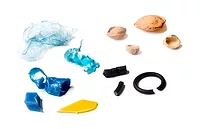Breakthrough Same-day Bacterial Analysis for Food Products
An increasing appreciation for the importance of food and microbiological safety has resulted in a demand for a rapid, high-throughput method for total viable count (TVC) quantification to deal with the increasing numbers of samples that require testing.
The industry standard for TVC determination (ISO:4833:2033), also known as aerobic plate count (APC), is widely used but presents users with some very significant drawbacks. The method is both material and labor intensive, requiring the preparation and analysis of multiple agar plates per sample. More importantly, the method is slow, with 48–72 hours typically required for a definitive result.
MOCON, in association with Luxcel Biosciences, has addressed these limitations with the development of the GreenLight™ 900 Series, a breakthrough, low-cost system with reduced labor and material, providing microbiological analysis in just hours.
Rapid determination of TVC/APC levels has an immediate impact on your business in the following ways:
• Measures microbiology quality immediately after delivery
• Fast decision-making toward suppliers
• Standardizes internal microbiology quality control for goods received
• Immediate grading of incoming products
• Rapid hygiene indicator of products
• Contributes to competitive advantage
• Constant monitoring of production process (hygiene)
This process results in safer foods for consumers.
How Does It Work? (The Really Simple Explanation)
This sensor technology is based on oxygen sensing. As microbes grow, they consume O2. The system measures bacterial O2 consumption and equates that to viable microbial load (live bacteria).
Accuracy
A strong correlation is observed between the GreenLight and the ISO:4833:2003 methods for the assessment of bacterial contamination, for example, in ground beef samples; Pearsons correlation coefficient = 0.961.
Available in Two Models
• Model 960 (AOAC approved), a 96 micotiter plate-based assay that provides rapid high throughput.
• Model 910 (AOAC approval pending), a vial-based system providing low to medium throughput.
Simple to Operate
The system does not require laboratory trained technicians to operate it.
Model 960 is a simple ‘mix and measure’ assay 96-well plate system. Using food homogenates, prepared as for traditional TVC/APC testing (with no further dilutions necessary) (ISO:4833:2033), probe, sample and oil are added in sequence and resultant aerobic TVC/APC values quantified using an appropriate calibration. The plate is measured kinetically on a fluorescence plate reader.
Model 910 uses the same preparation (no further dilution is necessary) with the samples being placed in a vial that already contains the sensor. Readings are taken by placing the vial into the sample receptor slot of the instrument, and results are recorded by the software. Each vial is supplied with a unique bar code that is automatically read during sensing, ensuring that results are recorded against the correct sample.
Variety of Testing Protocols
Operators have the option of a variety of testing protocols:
• Simple two-point pass/fail
• Multipoint mode – gives pass/fail and semi-quantitative TVC/APC (CFU/g) level
• Continuous mode – gives pass/fail and absolute TVC/APC (CFU/g) level
Wide Contamination Range
This system can measure aerobic bacterial respiration across a wide contamination range 100–108 CFU/g.
Same-day Results (including sample preparation time and incubation)
In comparison to the conventional approach, the GreenLight 900 series provides a much improved ‘time-to-result’ with less than or equal to 103 CFU/g detectable in approximately 12 hours compared to the 49 hours required by the standard method (≥108 CFU/g are detectable within 1 hour).
Saves Money
The system reduces preparation time with no further dilutions necessary, which also reduces media cost. It is less labor intensive, and there is no need to be an engineer or scientist to conduct tests. It reduces incubator space: three plates (288 tests) can be stacked in the same area occupied by six agar plates.
Standardizes Procedures
Results are recorded automatically within the software, removing the need for difficult and tedious counting and subjective observation of colony numbers.
Learn More
To obtain a copy of the GreenLight White Paper or for more information on the specific models, contact MOCON at info@mocon.com or phone us at 763-493-6370 or www.mocon.com/foodsafety.php.
Looking for quick answers on food safety topics?
Try Ask FSM, our new smart AI search tool.
Ask FSM →






